Click here to return to the main program page.
By Priyanka Verma, Sharda University
The 2024 Wutai International and Intensive Program on Buddhist Studies, held from August 7 to August 15, brought together scholars, students, and practitioners from around the world. This program took place at Mount Wutai 五臺山 in Shanxi 山西, China, a location of great historical and spiritual importance in Buddhism. The program was organized by The Wutai Shan Institute of Buddhism and Eastern Asian Culture 五臺山東方佛教文化研究院, with co-organization by From the Ground Up project at the University of British Columbia, Institute for Ethics and Religions Studies at Tsinghua University 清華大學倫理與宗教研究院. The Great Sage Bamboo Monastery 大聖竹林寺 graciously hosted the program.
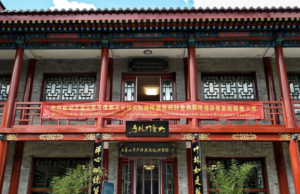
Seminar hall for the Wutai International and Intensive Program. Photo courtesy of The Wutai Shan Institute of Buddhism and Eastern Asian Culture.
Mount Wutai, the chosen venue for this intensive program, holds a special place in Buddhist tradition. As home to numerous monasteries and temples, it has long been considered a centre for Buddhist learning and spiritual practice. The site’s historical significance, combined with its breathtaking natural beauty, allowed participants to experience the living heritage of Buddhism in China. The serene environment, recognized as a UNESCO World Heritage site, added an enriching context to the academic and cultural experiences of all attendees.
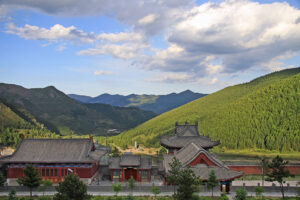
Vista of Mount Wutai at the Great Sage Bamboo Monastery. Photo by Wang Boyang.
The program commenced with an opening ceremony on August 7, 2024. The ceremony was led by Venerable Fohu 佛護 from the Great Sage Bamboo Monastery. Honourable Venerable Miaojiang 妙江, Vice President of the Buddhist Association of China, President of the Buddhist Association of Shanxi Province, and President of The Wutai Shan Institute of Buddhism and Eastern Asian Culture, welcomed the participants with opening remarks, followed by a speech from Venerable Kuan Guang 寬廣. Professor Jinhua Chen 陳金華 (University of British Columbia) addressed the audience, and Professors Barend ter Haar (University of Hamburg) and Marcus Bingenheimer (Temple University) also spoke as representatives of the faculty. Student representatives included Wei Xiang 魏翔 (Temple University), Shi Shang 石尚 (Capital Normal University), Antoine Cid (Inalco), Brianna Morseth (The Chinese University of Hong Kong), Ben Nun Avishay (Hebrew University of Jerusalem), Venerable Jeongwook 釋靜昱 (Seoul National University), and Venerable Jizhen Shi 釋寂真 (Mount Kuaiji Institute of Advanced Research on Buddhism). Prof. Chen concluded the ceremony by presenting the schedule and the code of conduct for the program.
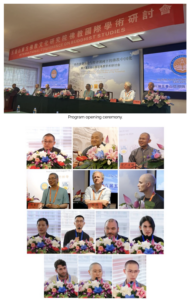
First row: Venerable Fohu 佛護, Venerable Miaojiang 妙江, and Venerable Kuan Guang 寬廣. Second row: Professor Jinhua Chen 陳金華, Professor Barend ter Haar, and Professor Marcus Bingenheimer. Third and fourth row: Wei Xiang 魏翔, Shi Shang 石尚, Antoine Cid, Brianna Morseth, Ben Nun Avishay, Venerable Jeongwook 釋靜昱, Venerable Jizhen Shi 釋寂真. Photos courtesy of The Wutai Shan Institute of Buddhism and Eastern Asian Culture.
After the ceremony, participants enjoyed a welcome banquet where participants had the opportunity to enjoy a variety of authentic dishes from Shanxi province. The banquet was not only a culinary delight but also a cultural experience as participants observed the traditional practice of saying prayers before each meal at the monastery. This ritual was a profound aspect of the cultural experience, allowing participants to engage with the spiritual practices that are integral to monastic life. Following the banquet, participants had the opportunity to explore the Great Sage Bamboo Monastery. This tour provided a closer look at the monastery’s historical and architectural significance, enhancing the overall experience of the program as a living classroom for the participants.
The program was carefully structured to maximize learning through various activities including seminars, lectures, interactive discussions, an international conference, and field visits. Over the course of nine days, participants engaged in three main seminars, each divided into multiple sessions, and attended lectures delivered by twelve distinguished scholars. The presence of 58 students from prestigious universities around the world contributed to a dynamic and diverse learning environment, enhancing the program’s ability to facilitate meaningful academic and cultural exchanges.
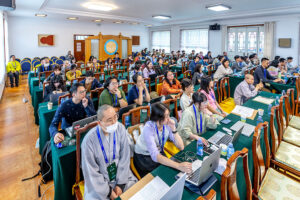
Program participants at a seminar. Photo courtesy of The Wutai Shan Institute of Buddhism and Eastern Asian Culture.
The first seminar, led by Prof. Chen, focused on the influence of media theory, particularly Marshall McLuhan’s ideas, on East Asian Buddhist studies. This seminar was divided into four sessions that explored how media shapes the transmission and interpretation of Buddhist texts and teachings. In the first session, Prof. Chen introduced McLuhan’s media theory and its relevance to Buddhist studies, arguing that the medium of communication significantly impacts the interpretation of Buddhist texts. The second session examined the relationship between material culture, communication mediums, and the messages conveyed in East Asian Buddhist traditions, highlighting how these elements influence the perception of Buddhism. The third session explored the complex relationships between the Buddhist Sangha and the state in medieval China, emphasizing how media played a role in these dynamics. The final session, analyzed the formation of Buddhist networks and communities, focusing on the role of media in establishing and sustaining these connections.
The second seminar, presented by Prof. ter Haar, explored regional religious groups during the late Ming and early Qing periods as expressions of Buddhist beliefs. This seminar provided insights into the religious dynamics of this transformative era through four sessions. The first session offered a historical overview of the White Lotus movement, highlighting its religious beliefs, social impact, and resistance to state authority. In the second session, Prof. ter Haar guided participants in identifying and interpreting primary sources related to the movement. The third session examined how these groups maintained Buddhist beliefs amid state repression, highlighting their adaptability. The final session focused on the methodologies for studying these religious groups, equipping participants with critical skills for engaging with historical texts.
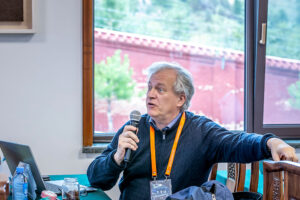
Barend ter Haar. Photo courtesy of The Wutai Shan Institute of Buddhism and Eastern Asian Culture.
The third seminar, led by Professor Meir Shahar (Tel Aviv University), offered an in-depth examination of lay Buddhist ritual masters in rural South China and their associated ritual scriptures. The seminar’s four sessions provided a comprehensive understanding of rural Buddhist practices and the texts that underpin them. The first session introduced the roles of lay masters in rural communities who often blended Buddhist teachings with local traditions and played a vital role in religious life. The second session explored the textual sources of these rituals, emphasizing the importance of both canonical and non-canonical scriptures in reflecting local needs. The third session traced the historical journey of Buddhist texts, highlighting their preservation and adaptation over time. The final session examined unique rituals performed for the protection of animals, showcasing the integration of Buddhist principles with practical rural life.
In addition to the seminars, the program featured a series of lectures that offered participants insights into specialized areas of Buddhist studies.
On August 11, the first guest lecture was delivered by Professor Sheng Kai 聖凱(Tsinghua University) on “Tang-Song Transition and the Periodization of Chinese Buddhist History,” he proposed new ways to understand the Sinicization of Buddhism and its intertwining relationship with Confucianism and Daoism.
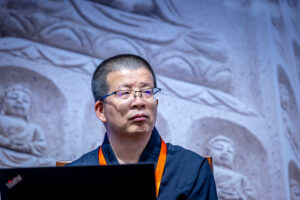
Sheng Kai. Photo courtesy of The Wutai Shan Institute of Buddhism and Eastern Asian Culture.
After lunch, Professor Kim Youn-mi 金延美 (Ewha Womans University) delivered an engaging lecture on the “Buddhist Teaching and Ritual Embodied in Architecture.” She explored how Buddhist architecture, specifically Liao dynasty pagodas, represents teachings and rituals, highlighting the symbolic significance of these structures as spaces where physical and spiritual worlds meet.
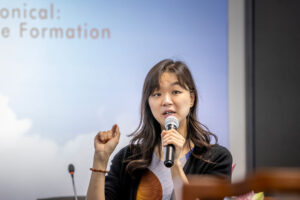
Youn-mi Kim. Photo courtesy of The Wutai Shan Institute of Buddhism and Eastern Asian Culture.
Following a short tea break, Prof. Bingenheimer discussed on the topic “Last Translators: How Machine Translation Might Change Buddhist Studies.” He explained the potential of machine translation in Buddhist studies, examining how advanced language models could transform the accessibility of ancient texts and the implications for power dynamics between scholars and non-experts.
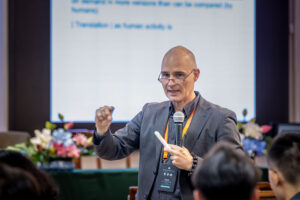
A key highlight of the program was the international conference held on August 11–15, titled, “Canonical, Non-Canonical and Extra-canonical: Interdisciplinary and Multi-media Studies of the Formation, Translation and Transmission of Buddhist Texts.” This conference featured presentations from scholars on various aspects of Buddhist texts, art, and history, providing a platform for sharing new research and ideas. The opening ceremony of the conference was held on August 11, at the Great Sage Bamboo Monastery, attended by nearly 200 participants, including students, scholars, experts, Buddhist Masters, and guests from various fields. Experts and scholars at the opening ceremony believed that as one of the important topics of this symposium, in the context of the new era of AI intelligence, the translation of Buddhist scriptures is not only a language conversion, but also a cultural integration, which will lay a new and more solid foundation for the development of Buddhism in China. In the future, Buddhist culture will continue to serve as a bridge for cultural exchanges between China and the West, and contribute more wisdom and strength to enhance mutual understanding and respect between human civilizations. After the ceremony, attendees enjoyed a welcome dinner. Additional details about the conference and panels is available in “Report on ‘Canonical, Non-Canonical, and Extra-Canonical: Interdisciplinary and Multi-media Studies of the Formation, Translation, and Transmission of Buddhist Texts’ and ‘The Sixth Annual International Forum on Wutai Faith and Culture’ – A Reflection.”After the conference welcome dinner, Ven. Kuan Guang delivered a lecture on “Learning from the Past: Implications of the Institution of Medieval Buddhist Translation for Contemporary Translation Projects of Buddhist Scriptures.” Before the lecture began, Ven. Kuan Guang led a brief meditation session to relax the participant’s minds and bodies and then he began and took participants back to medieval Buddhist translation practices, emphasizing the relevance of these historical methods for contemporary translation projects of Buddhist scriptures.
The last lecture of the day delivered by Venerable Jie Fa 戒法 titled, “Chan Paths to Enlightenment”, provided insights into the distinctive practices and teachings within the Chan tradition that guide individuals toward spiritual awakening.
On the following day, Professor Hamada Tamami 濱田瑞美 (Yokohama University of Art and Design) delivered a lecture on “Iconography and Inscriptions on the Pictorial Representations of the Bhaisajyaguru Sutra in Dunhuang Caves.” She explained how art and text interact to convey Buddhist teachings.
Professor Sun Yinggang 孫英剛 (Zhejiang University) concluded the day with his lecture on “The Remaking of the Buddha’s Jātaka Stories in Gandhāra” and offered insights into the cultural and artistic adaptations of these narratives.
On the final day of the program, Professor Chen Juxia 陳菊霞 (Shanghai University) delivered a lecture on “Dunhuang Grotto Art: New Perspective and New Thoughts.” She analyzed the concepts that reflect the religious functions of these caves, providing new perspectives on their artistic and functional aspects.
Lastly, Professor Zhang Xiaoyan 張小豔 (Fudan University) discussed “Looking at the Formation of Early Buddhist Texts from Dunhuang and Turpan Documents,” shedding light on their distinct features and historical context, and contributing to our understanding of the evolution of Buddhist textual traditions.
The intensive program concluded with a closing ceremony on August 13, 2024, with Venerable Yuan Xing presiding over the event. Ven. Miaojiang and Prof. Chen presented completion certificates to the participants, recognizing their contributions to the academic discussions. Ven. Miaojiang and Ven. Kuan Guang also awarded honorary certificates to the volunteers, acknowledging their hard work and dedication throughout the seminar. In his closing speech, Ven. Miaojiang expressed gratitude to all the experts and scholars who made academic contributions to the seminar. He also thanked the permanent residents of the Great Sage Bamboo Grove Monastery for their full support, the media friends for their coverage, and the volunteers for their tireless efforts both onstage and behind the scenes.
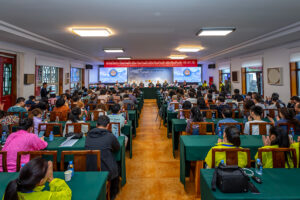
Closing ceremony. Photo courtesy of The Wutai Shan Institute of Buddhism and Eastern Asian Culture.
The closing ceremony included several question-and-answer sessions with Ven. Miaojiang. These sessions were particularly illuminating and provided participants with valuable perspectives on the application of Buddhist principles in everyday life. A participant from Arizona State University inquired about the essence of “Manjushri’s Dharma” after spending seven days at the Great Sage Bamboo Monastery. Ven. Miaojiang responded by explaining that Manjushri’s Dharma is the wisdom that permeates all aspects of existence, from mountains and rivers to every blade of grass. He emphasized that true understanding of this wisdom comes from using the heart and mind sincerely and deeply, rather than merely through intellectual inquiry.
Another participant from University of Oxford, asked about the difference between knowledge and wisdom. Ven. Miaojiang distinguished knowledge as “finite and rooted in intellectual pursuits, whereas wisdom is infinite, transcending intellectual understanding and manifesting in truth and reality.” He emphasized that wisdom must be sought with a sincere heart, beyond mere scholarly knowledge.
A participant asked how to maintain meditative concentration and single-mindedness in daily life after leaving the serene environment of the Great Sage Bamboo Monastery. Ven. Miaojiang advised that the practice of mindfulness and adherence to the principles of Buddhism should continue in everyday activities. He highlighted the importance of living in accordance with Buddhist teachings and remaining in a state of “right path and right mindfulness,” even amid worldly distractions.
In his concluding remarks, Ven. Miaojiang offered his blessings for peace, success, and spiritual fulfilment. He expressed his hope that all participants would carry the spirit of Mount Wutai with them, applying the lessons learned to their personal and professional journeys. He concluded by inviting everyone to return to Mount Wutai in the future, where they would always find a welcoming place. The ceremony marked the end of an enriching experience, with reflections on the academic and personal growth fostered during the program.
After the closing ceremony of the program, all attendees headed to Jinxiu Mountain Villa for the farewell banquet. The atmosphere was warm and joyful, with a large gathering of attendees and volunteers to celebrate the end of the conference and program. Students enjoyed a hearty dinner together, and it was a great chance to connect, with many participants exchanging contact information to stay in touch. The evening featured performances by some participants, along with special musical and singing performances, creating a delightful way to wrap up the event.
On the morning of August 14, participants conducted a field visit to several cultural heritage sites at Mount Wutai, including Longquan Temple 龍泉寺, Pushou Monastery 普壽寺, Bishan Temple 壁山寺, and Nanshan Temple 南山寺. The first stop was Longquan Temple, also known as Jiulonggang Temple 九龍崗. Set against the mountain, this temple features three main courtyards: the East Courtyard with the main Buddha halls and the Drum and Bell Towers, the Central Courtyard with the main pagoda and the tomb of Master Puji 普濟禪師墓塔, and the West Courtyard with the Manjusri Hall and the tomb of Monk Youjingweng 岫净文法師墓塔. The temple is renowned for its beautiful architecture and historical significance. It is named after a spring that flows from a stone dragon’s mouth, which is believed to be linked to the Jiulonggang 九龍缸 vein. According to legend, the temple’s name comes from the story of Manjusri Bodhisattva suppressing a dragon under the mountain.
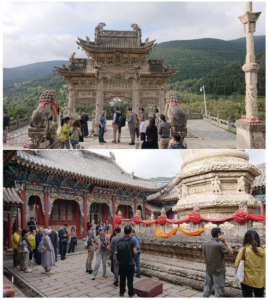
Top: Stone archway at the entrance of Longquan Temple 龍泉寺. Bottom: Pagoda and the tomb of Master Puji 普濟禪師墓塔 at the central courtyard of Longquan Temple 龍泉寺. Photos courtesy of Carol Lee.
Next, participants visited the Pushou Monastery, also known as the Wutaishan Bhikkhuni Academy of China, which was originally built during the Northern Song Dynasty and rebuilt in 1991. The monastery, covering 43,320 square meters, emphasizes harmonious living and self-cultivation, guided by principles from the Avatamsaka Sutra and Vinaya code. During the visit, participants had the opportunity to dine lunch there with the bhikkhunis, allowing them to experience the peaceful ambiance and observe the dedicated monastic daily life of the nuns. It was inspiring to witness their commitment to Buddhist practice and education. After lunch, some professors and students had to leave the field visit early in order to attend another intensive program in Xiamen from August 15–26.
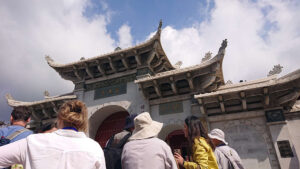
Pushou Monastery 普壽寺. Photo courtesy of Carol Lee.
The participants then proceeded to Bishan Temple, originally built during the reign of Emperor Xiaowen of the Northern Wei Dynasty (467-499) and initially named “Beishan Temple” 北山寺. It was later rebuilt and renamed “Puji Temple” 普濟寺 during the Ming dynasty. The temple boasts four significant halls: Tianwang Palace 天王殿, dedicated to the Four Heavenly Kings; Thunder Sound Palace 雷音寶殿, notable for its distinctive architectural style; Ring Hall Palace, serving as a place for meditation and worship; and Maitreya Palace, which venerates the Future Buddha. The temple’s profound historical significance and serene spiritual environment left a lasting impression on the participants.
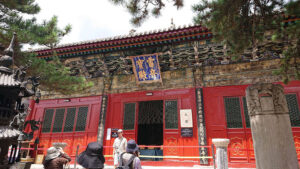
Thunder Sound Palace 雷音寶殿 at Bishan Temple 壁山寺. Photo courtesy of Carol Lee.
The final visit was to Nanshan Temple, originally built during the Yuan Dynasty and known as Dawan-shengyouguo Temple 大萬聖佑國寺. The temple’s unique, layered design and hillside location created a mystical feel, with winding paths leading through halls adorned with detailed stone carvings and painted sculptures. From the top of Youguo Temple, participants enjoyed impressive views of Mount Wutai. The temple was a fascinating blend of Buddhist, Taoist, and Confucian elements, making it a culturally rich experience. After exploring Nanshan Temple, Students returned to their hotel for some rest before heading out for dinner at the Great Bamboo Grove Monastery, where they enjoyed the last meal together.

Top: The Hall of Sakyamuni 大雄寶殿 at the first level of Nanshan Temple 南山寺. Photo courtesy of Carol Lee. Bottom: Valley vista of Mount Wutai from the third level of Nanshan Temple 南山寺. Stitched panorama based on video by Youn-mi Kim.
The next day, on August 15, all participants departed from the hotels, marking the end of a memorable and enriching journey at Mount Wutai. The program left them with a renewed sense of purpose and inspiration, and the knowledge, experiences, and connections gained that will undoubtedly influence their future academic pursuits and personal journeys.
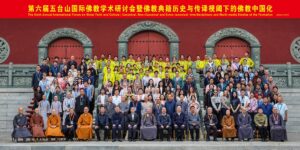
Group photo of 2024 Wutai International and Intensive Program participants, ‘Canonical, Non-Canonical, and Extra-Canonical’ conference panelists, and local organizers. Photo courtesy of The Wutai Shan Institute of Buddhism and Eastern Asian Culture.
Author Bio:
Priyanka Verma is a PhD research scholar in History at Sharda University. She completed her graduation and postgraduation from the University of Delhi. Her research interests include Monastic Buddhism, Ancient India, Religious Studies, and Semantics.








